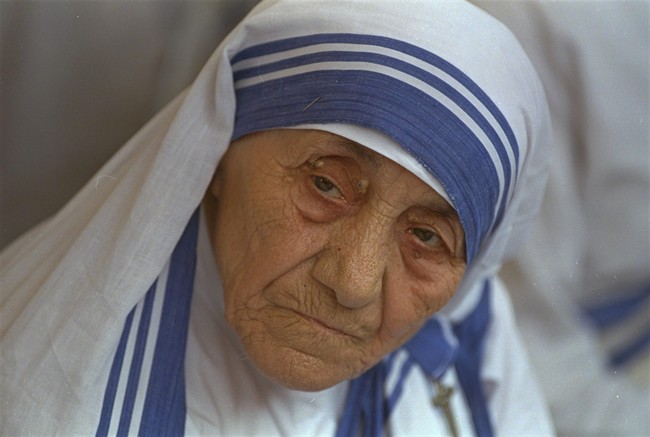Mother Teresa is set to officially become a saint on Sept. 4 — even though some say she is anything but.

The popular opinion about the Albanian-born nun, whose real name was Agnes Gonxha, is that she cared for the “poorest of the poor” and the dying in Calcutta, India.
At the time of her own death on Sept. 5, 1997, the 87-year-old’s charity ran roughly 600 orphanages, soup kitchens, homeless shelters and clinics around the world.
Pope Francis is a big fan. So why aren’t others?
Genevieve Chenard of Université de Montréal’s Department of Psychoeducation helped break it down for us. In 2013, she was one of three Canadian researchers to put out a French-language study the title of which translates to “The dark side of Mother Teresa.”
Here are four reasons, the researchers say, the legend of Mother Teresa may not be all it’s cracked up to be.
1. Misappropriation of funds
Millions of dollars are believed to have poured in to her foundation.
“All the money served to build houses for the sisters of her order or [was sent] to the Vatican. Nothing was given to the poor,” Chenard said.
“She received money from dictators in Haiti and she was, like the rest of the world, probably aware of the situation in Haiti at that time. There was torture and the president stole a lot of money for his own purpose instead of helping the population.”
2. Poor treatment of the dying
Doctors who visited Mother Teresa’s “homes for the dying” in Calutta, India were disturbed by the conditions.
The Lancet also published a piece in 1994 about the situation. Chenard claims the Missionaries of Charity had to shut down the facility a few years ago due to fears of an epidemic breaking out.
Mother Teresa reportedly defended the suffering found within the home during her lifetime, according to the late atheist and journalist Christopher Hitchens: “There is something beautiful in seeing the poor accept their lot, to suffer it like Christ’s Passion. The world gains much from their suffering.”
You can watch his documentary “Mother Teresa: Hell’s Angel” below:

Get breaking National news
The Canadian scholars pointed out that when Mother Teresa required palliative care, she received it in a modern American hospital.
3. Tough stance on abortion and contraception
Mother Teresa took a hard stance on abortion and contraception. She saw no place for either.
In her 1979 acceptance speech of the Nobel Peace Prize, she called abortion “the greatest destroyer of peace… It is a direct war, a direct killing. A direct murder by the mother herself.”
WATCH: Pope warns church to stop obsessing on abortion, gay marriage
During that same speech she advocated the “natural way of abstaining.”
You can watch the full thing below.
4. Myth of the first miracle
To become a saint, you need to be responsible for two posthumous miracles.
Her first “miracle” has been called into question. Monica Besra, living 740 kilometres northeast of Calcutta, claimed Mother Teresa’s power cured her of a stomach tumor on Sept. 5, 1998 (the first anniversary of the nun’s death).
The woman’s husband and doctors disagreed.
“It is much ado about nothing,” Seiku Besra told Time in 2002. “My wife was cured by the doctors and not by any miracle.”
Her doctors also said she didn’t even have a tumor, but a lump that was steadily treated.
The second miracle responsible for her canonization concerned the inexplicable cure of a Brazilian man suffering from a viral brain infection that resulted in multiple abscesses. By Dec. 9, 2008, he was in a coma and dying, suffering from an accumulation of fluid around the brain.
He woke up without pain at one point and was declared to be symptom-free. The Vatican later attributed the cure to fervent prayers to Mother Teresa’s intercession by the man’s wife.
WATCH: Mother Teresa is set to receive the Catholic Church’s highest honours just two decades after her death
Mohan Bhagwat, the head of a Hindu nationalist group spoke out against Mother Teresa last year, telling the Times of India her “work had ulterior motive, which was to convert the person who was being served to Christianity.”
Chenard takes a softer stance.
“When she began her work, we think she really wanted to help,” she said. “The thing is, she wanted to help people to get closer to God and into her mind, people need to suffer for that just as Jesus suffered on the cross.”
Seeing how beloved she’d become, some believe the Church just wanted to capitalize on her celebrity.
“It’s all about politics. Showing one Church is better than the other… when they have a figure like Mother Teresa, they use it, that’s it. Every political party does that.”
‘A teaching moment’
Vatican journalist John Allen recently wrote that this is all simply a “teaching moment for the proper Catholic understanding of sainthood.”
Declaring someone a saint doesn’t necessarily equal “a claim of moral perfection,” he explained.
“It doesn’t mean they never made mistakes or were utterly free of blind spots.”
“One can question certain aspects of a person’s life and choices without disqualifying them for a halo.”
SOUND OFF: What do you think? Is Mother Teresa worthy of sainthood? Share your thoughts in the comments section below.


Comments